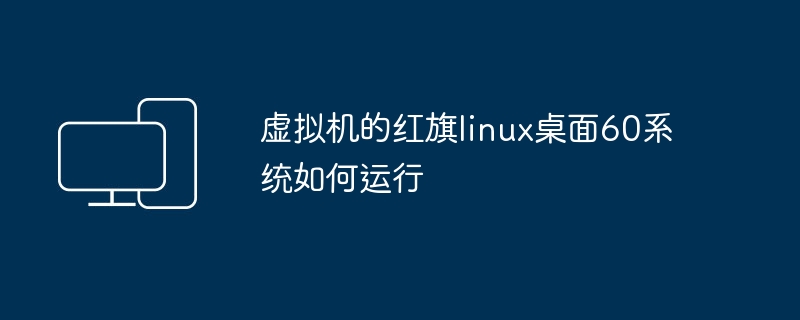 Computer Tutorials
Computer Tutorials
 Computer Knowledge
Computer Knowledge
 Red Flag Linux Desktop 60 System Usage Guide in Virtual Machines
Red Flag Linux Desktop 60 System Usage Guide in Virtual Machines
Red Flag Linux Desktop 60 System Usage Guide in Virtual Machines

How to run the ISO file of the red flag linux desktop 6 0 system of the virtual machine
yyy,/media/cdrom is the mounting directory). Simply switch to the /media/cdrom directory to use the contents of the tool tray.
2. Establish a LAN between the virtual machine and the host: Add a network card to the virtual machine. The network card type is host-only.
3. Run the iso file in the virtual machine; media/xxx/cdrom (/. If the iso file already exists in the Linux system, use the mount command mount -o loop / to copy the host tool disk to Linux: in In the virtual machine settings, point the virtual machine CD-ROM drive to your tool disk. In Linux, mount this disk; hdc is your virtual machine CD-ROM drive.iso/media/tmp; if the iso file exists in XP, point the virtual machine CD-ROM drive to Point to this iso file, and other steps are the same as question 1: mount /dev/hdc /dev/So many problems, so few points! Haha
==================================
1
How to use red flag linux 6 0 sp3
Have you installed it? ?
Which function do you want to know? Generally, such questions are asked by people who are completely ignorant of Redflag.
So, you install Redflag first and try to use the various software in it yourself. This will be considered progress for you.
After coming into contact with Redflag's desktop environment, it is easier to learn software installation and other things....
You can install it in a virtual machine first, which is to use a software to simulate a computer and install the system in that virtual computer. This will not have a great impact on the system. After all, you have no experience in installing Redflag. .
Now, you first download the virtual machine software virtualbox. . After installing the virtual machine software, use that to install the virtual system. .
============The virtual system needs to run under the current operating system, so there may be some lags, especially Redflag. It is recommended that you use ubuntu
Download the ISO image, why is it like this? ?
Burn the ISO image to a CD and you can install it. .
The above is the detailed content of Red Flag Linux Desktop 60 System Usage Guide in Virtual Machines. For more information, please follow other related articles on the PHP Chinese website!

Hot AI Tools

Undresser.AI Undress
AI-powered app for creating realistic nude photos

AI Clothes Remover
Online AI tool for removing clothes from photos.

Undress AI Tool
Undress images for free

Clothoff.io
AI clothes remover

AI Hentai Generator
Generate AI Hentai for free.

Hot Article

Hot Tools

Notepad++7.3.1
Easy-to-use and free code editor

SublimeText3 Chinese version
Chinese version, very easy to use

Zend Studio 13.0.1
Powerful PHP integrated development environment

Dreamweaver CS6
Visual web development tools

SublimeText3 Mac version
God-level code editing software (SublimeText3)

Hot Topics
 How to Solve Windows Error Code "INVALID_DATA_ACCESS_TRAP" (0x00000004)
Mar 11, 2025 am 11:26 AM
How to Solve Windows Error Code "INVALID_DATA_ACCESS_TRAP" (0x00000004)
Mar 11, 2025 am 11:26 AM
This article addresses the Windows "INVALID_DATA_ACCESS_TRAP" (0x00000004) error, a critical BSOD. It explores common causes like faulty drivers, hardware malfunctions (RAM, hard drive), software conflicts, overclocking, and malware. Trou
 ENE SYS Maintenance: Tips and Tricks to Keep Your System Running Smoothly
Mar 07, 2025 pm 03:09 PM
ENE SYS Maintenance: Tips and Tricks to Keep Your System Running Smoothly
Mar 07, 2025 pm 03:09 PM
This article provides practical tips for maintaining ENE SYS systems. It addresses common issues like overheating and data corruption, offering preventative measures such as regular cleaning, backups, and software updates. A tailored maintenance s
 5 Common Mistakes to Avoid During ENE SYS Implementation
Mar 07, 2025 pm 03:11 PM
5 Common Mistakes to Avoid During ENE SYS Implementation
Mar 07, 2025 pm 03:11 PM
This article identifies five common pitfalls in ENE SYS implementation: insufficient planning, inadequate user training, improper data migration, neglecting security, and insufficient testing. These errors can lead to project delays, system failures
 How do I edit the Registry? (Warning: Use with caution!)
Mar 21, 2025 pm 07:46 PM
How do I edit the Registry? (Warning: Use with caution!)
Mar 21, 2025 pm 07:46 PM
Article discusses editing Windows Registry, precautions, backup methods, and potential issues from incorrect edits. Main issue: risks of system instability and data loss from improper changes.
 Discover How to Fix Drive Health Warning in Windows Settings
Mar 19, 2025 am 11:10 AM
Discover How to Fix Drive Health Warning in Windows Settings
Mar 19, 2025 am 11:10 AM
What does the drive health warning in Windows Settings mean and what should you do when you receive the disk warning? Read this php.cn tutorial to get step-by-step instructions to cope with this situation.
 How do I manage services in Windows?
Mar 21, 2025 pm 07:52 PM
How do I manage services in Windows?
Mar 21, 2025 pm 07:52 PM
Article discusses managing Windows services for system health, including starting, stopping, restarting services, and best practices for stability.
 which application uses ene.sys
Mar 12, 2025 pm 01:25 PM
which application uses ene.sys
Mar 12, 2025 pm 01:25 PM
This article identifies ene.sys as a Realtek High Definition Audio driver component. It details its function in managing audio hardware, emphasizing its crucial role in audio functionality. The article also guides users on verifying its legitimacy
 why won't driver asio.sys load
Mar 10, 2025 pm 07:58 PM
why won't driver asio.sys load
Mar 10, 2025 pm 07:58 PM
This article addresses the failure of the Windows asio.sys audio driver. Common causes include corrupted system files, hardware/driver incompatibility, software conflicts, registry issues, and malware. Troubleshooting involves SFC scans, driver upda





